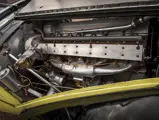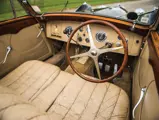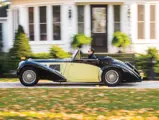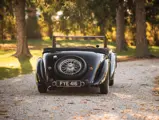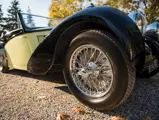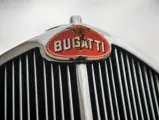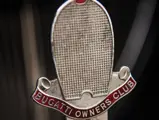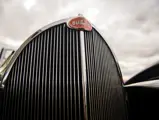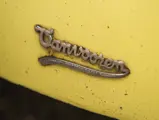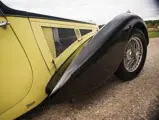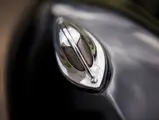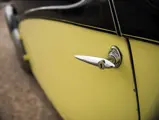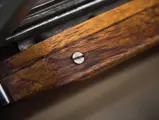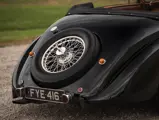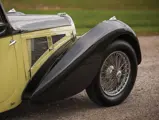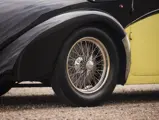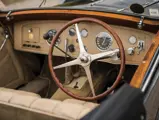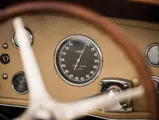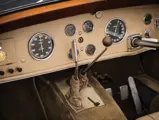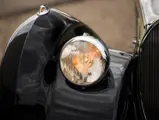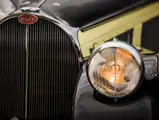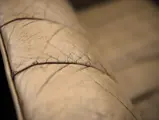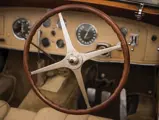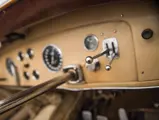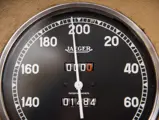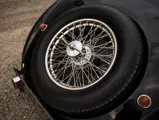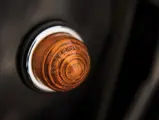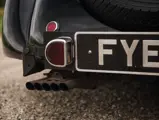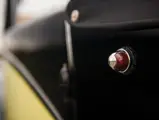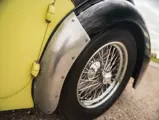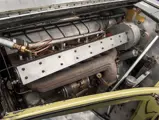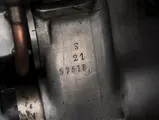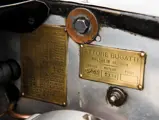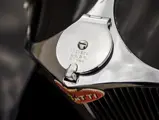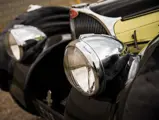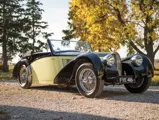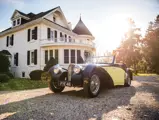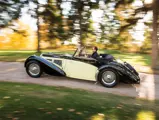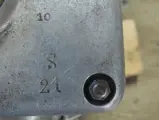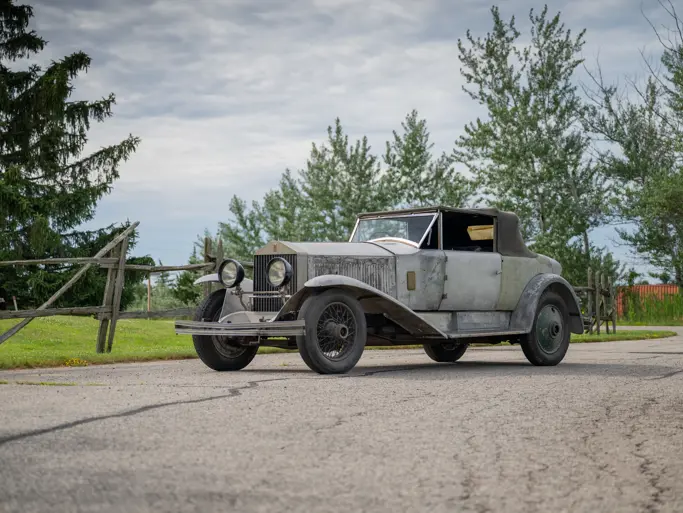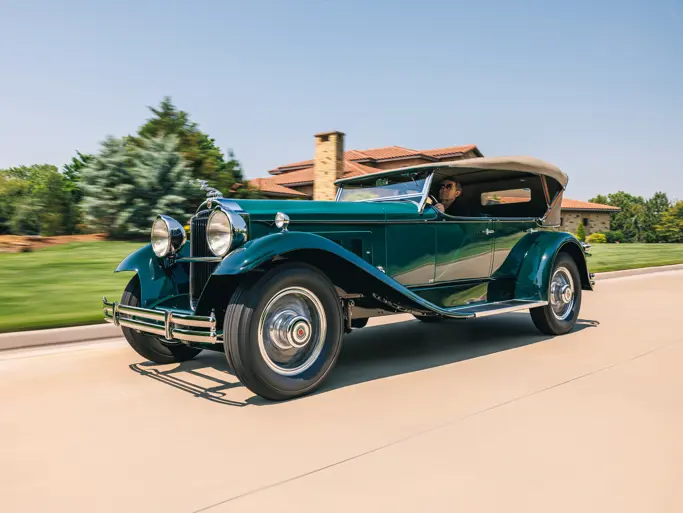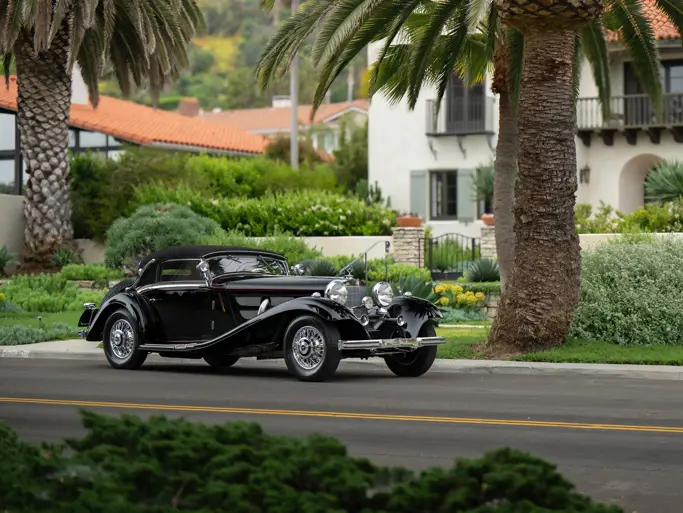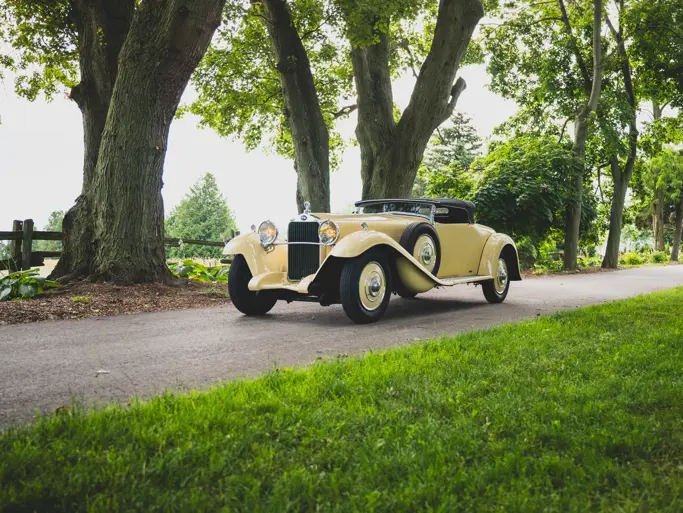Amelia Island 2017
1937 Bugatti Type 57S Cabriolet by Vanvooren
{{lr.item.text}}
$7,700,000 USD | Sold
 | Amelia Island, Florida
| Amelia Island, Florida
{{internetCurrentBid}}
{{internetTimeLeft}}

- One of just 42 Type 57S chassis produced
- One of four Type 57S cabriolets built by Vanvooren; one of three extant
- Owned since new by only a handful of well-known Bugatti enthusiasts
- Unchallenged and well-documented history, including reports from Pierre-Yves Laugier and David Sewell
- Featured in The Bugatti Type 57S by Julius Kruta and Bernhard Simon
- Highly original, unrestored example of a rare and lovely Molsheim legend
- Retains its original chassis, body, engine, and gearbox
170 bhp 3,257 cc DOHC inline eight-cylinder engine with updraft carburetor, four-speed manual transmission, front and rear live axles with semi-elliptical front leaf springs, quarter-elliptical rear leaf springs and De Ram shock absorbers, and four-wheel drum brakes. Wheelbase: 130 in.
THE ULTIMATE EXPRESSION
The Paris Auto Salon of October 1936 marked a propitious crossroads for Alsatian manufacturer Bugatti. There, the company introduced a second-series iteration of the vaunted Type 57, the sporting road car designed by Ettore Bugatti’s son, Jean, that featured a 3.3-liter dual overhead-cam eight-cylinder engine and competition-inspired chassis.
In addition to the second-series Type 57, Bugatti also unveiled two sporting variants of the model, the 57C and the 57S. While the former featured a supercharged engine (the nomenclature’s C standing for compressor), the latter was an even more purpose-built sports car. In fact, it can be argued that the 57S is an entirely distinct model and might have more suitably had its own unique type designation to put things into clear perspective.
The Type 57S was built upon a completely re-engineered chassis that was both shorter and lower (the S label for surbaisse, French for "lowered"). The front axle was articulated in halves, and the rear axle passed through the frame rather than under it for a lower overall stance. Also equipped with a specially tuned engine with a higher compression ratio of 8.5:1, it featured a dry sump to accommodate the lowered center of gravity, also useful for competition, as was its magneto-driven ignition. The Type 57S was fitted with a low-mounted radiator that wore a handsome V-shaped grille in the classic Bugatti motif for, as might be presumed, its aerodynamic effect at high speed.
An advertisement printed a year later in conjunction with the 1937 Paris Salon demonstrated how successful the Type 57S was in racing in its first 12 months, claiming three competition victories during 1936 (the French Grand Prix, La Marne Grand Prix, and the Commings Grand Prix), and later that success continued with four in 1937 (the Pau Grand Prix, Bone Grand Prix, La Marne Grand Prix, plus the prestigious 24 Hours of Le Mans). Furthermore, the 57S set records on some 14 different types of event, including a speed average of 85.07 mph at Le Mans.
The 57S was available in three forms of factory coachwork: a roadster, the Atalante coupe, or the ultra-rare Atlantic coupe (easily among the most coveted and valuable cars on Earth). The latter two coupe styles accounted for approximately 20 examples of the 42 cars that were ultimately sold through May 1938 (when the competition-oriented 57S was quietly discontinued as 57 and 57C road car sales flourished). Many of the remaining 22 examples were sold as rolling chassis and dispatched to the buyer’s coachbuilder of choice, including Gangloff, Corsica, Letourneur et Marchand, and Vanvooren of Paris. Particularly desirable among the various Type 57 iterations, the 57S examples were often maintained and raced in niche events in Europe during the 1950s and ’60s. Now the subject of utmost scrutiny and respect, the model has evolved into one of the collector car community’s golden grails, a legendary automobile epitomizing the finest in competition heritage, aesthetic design, engineering, and performance.
CHASSIS NUMBER 57513
Claiming extreme rarity and a virtually airtight chain of ownership that traces to its delivery date, chassis 57513 also features the original factory-equipped matching-numbers engine and gearbox, mated to its original chassis and body. According to the synthesized research of marque experts Pierre-Yves Laugier, David Sewell, and Bugatti S.a.S. historian Julius Kruta (author of The Bugatti Type 57S), this chassis was initially sold on trade in early 1937 to Francois Labesse, the scion of an eponymous mining technology company based in Paris. Mr. Labesse had ironically lost a leg during World War I, and so his chauffeur Jean was enviably tasked with hauling his employer around in a small collection of sporting automobiles, including a Bugatti Type 46 (chassis 46435) that he purchased in November 1932.
Labesse ordered his Type 46 with coachwork by Vanvooren, and this marked the beginning of a consistent preference he showed for the carrosserie nestled in the Parisian suburb of Courbevoie. The trend continued in May 1935, when Labesse purchased Type 57 chassis number 57269, which he ordered with four-seat drophead coupe coachwork from Vanvooren. By early 1937 Labesse desired the ultimate upgrade to a Type 57S, so he traded 57269 back to the factory on deposit for 57513. On 22 March, this 57S chassis was completed and shipped by train to Courbevoie to be bodied as a cabriolet. Chassis 57513 is one of only four such cabriolets built by Vanvooren on the Type 57S chassis, of which only three are known to survive today; the other two are now, respectively, located in the Schlumpf Collection in Alsace and a private collection in the United Kingdom.
On 7 July 1937, the Type 57S was delivered to Labesse’s Parisian headquarters through Bugatti’s Avenue Montaigne showroom. Though factory records are apparently inexact regarding the original color livery, Francois Labesse’s nephew recalls the Bugatti being finished in black paint with a thin red line. Labesse enjoyed being chauffeured around in 57513 for less than two years before he passed away in early 1939 at the age of 58, and when his brother-in-law offered the car for sale in spring 1939, the odometer displayed 8,000 kilometers.
For the next few months, the Type 57S was garaged and maintained by Gaston Docime, a Bugatti expert in Neuilly sur Seine who tended all of Mr. Labesse’s cars. The aforementioned marque historians contend that 57513 was most likely sold into British ownership during the summer of 1939, as it was indisputably registered in Great Britain in June 1939 under the tag FYE 416.
The first British owner of record was Dr. Tomas Harris (or de Tomaso by some accounts), who probably used the Bugatti strictly as a road car, as there is no known racing record under his name. During the early 1950s, the 57S was acquired by well-known Bugatti enthusiast Jack Lemon Burton, and he was photographed with the car at the Bugatti Owner Club’s Annual Prizegiving Party at the Welcombe Hotel in Stratford-on-Avon on 15 February 1953, as shown in a contemporary issue of the club magazine, Bugantics.
In 1954 the Bugatti was sold to another well-known British aficionado, Ronnie Symondson, who also owned chassis number 57375, the ex-Embiricos Tourist Trophy 57S. At the BOC Members Testing Weekend at Prescott on 27 March 1954, Symondson entered the cabriolet and achieved a best time of 58.6 seconds, as depicted in the May 1954 issue of Bugantics. On 9 May, the car took second place in the Bugatti handicap class at the National Hillclimb at Prescott, setting an impressive time of 55.84 seconds.
According to Bugatti Register editor David Sewell, Symondson likely entered the car at Silverstone on 19 June, and a day later it was part of the three-car Bugatti team who excelled at Shelsley Walsh. A photo in the August 1954 issue of Bugantics shows Symondson at the summit of Shelsley Walsh in 57513.
Later in 1954, Symondson used the 57S as a touring car for vacationing through continental Europe, an adventure he recounted in the November 1954 issue of Bugantics. While traveling the 57S was sidelined with engine problems, so Symondson used the opportunity to visit the Molsheim factory, where a new cylinder block and pistons were fitted. After returning to Britain, the owner occasionally used the car in further BOC events, though his other Type 57S was favored as better suited for racing. He further modified and updated some mechanical elements with the addition of Koni shock absorbers, and a hydraulic brake system to replace the notorious factory mechanical brakes.
In 1962 the 57S was sold to T.A. “Bob” Roberts, former vice president of the British Bugatti Club and a founder and director of the Bugatti Trust. Further issues of Bugantics show Mr. Roberts taking the car to Prescott in May 1962, and that winter he conducted some cosmetic work on the car, eschewing by then two-tone black over grey-blue paint for a new black over yellow, which it wears to this day. The bonnet apertures were modified with plated-steel mesh cooling grilles in place of the original louvered sides, and this round of freshening appears to have included a change in the headlamps from the original bumper-level faired-in units for the higher bullet-style components currently fitted to the coachwork, each modification making the car more purposeful and user-friendly. The 57S was next photographed at the International Bugatti Rally in May 1963, as printed in the spring 1964 issue of Bugantics.
During his ownership, Mr. Roberts removed the original engine (number 21S), retaining it as a spare, and replaced it with an unnumbered 57G competition engine that had served as an extra for the Bugatti factory team at Le Mans in 1937. Because he ultimately owned more powerful racing machines, the 57S was soon relegated to sparing road use, and later in his 30-year ownership the car was displayed in the Midland Motor Museum in Bridgnorth, Shropshire.
After Mr. Roberts’ passing in 1990, the rare Type 57S was offered by his estate for the first time in three decades. Displayed at Rétromobile in Paris in February 1991, the beautiful Bugatti was sold on 10 June to Claude Decoster, president of the French Bugatti Club. He drove the car in several events, including the 1992 International Bugatti Rally in France, and the 1994 Bugatti Rally in Italy, where it was displayed on the Piazza San Marco in Venice. Mr. Decoster eventually commissioned Henri Novo to remove the 57G engine and re-install the original factory-equipped motor, which currently remains fitted.
In 1995 the consignor, a respected collector based in New York, purchased the rare cabriolet. Since then, the Bugatti has largely been domiciled on static display within his collection, though in recent years the respected Stu Laidlaw of Redding, Connecticut, was commissioned to return the car to a basic state of driving operation.
In early 2016, the remarkable Bugatti was submitted to RM Auto Restoration, whose esteemed technicians rebuilt the clutch, and refitted the original factory gearbox. The car is also accompanied by ancillary factory-original components such as the original aluminum fan and De Ram rear shock absorbers, the latter parts essentially being unobtainium items. It should be noted that the original engine is currently fitted with the special competition carburetor from the 57G engine, which is extremely rare, with only a handful developed and produced by Bugatti for the ‘Tank’ streamlined racers (of which only one survives today, in the Simeone Museum). This higher-capacity carburetor adds usefully to horsepower while preventing fuel starvation for sustained high-speed driving in endurance events such as Le Mans. While running and driving functionality has been restored to 57513, a more comprehensive overhaul is recommended for anyone who wishes to indulge in vigorous motoring or road event use.
With its documented chain of just six private caretakers since 1939, this rare and undisputedly lovely Vanvooren-built cabriolet is one of only three such Type 57S examples remaining in existence. It has largely been absent from the Bugatti enthusiasts’ view in recent decades and is now being offered for the first time in 22 years. This remarkably authentic Type 57S would thrill connoisseurs of French coachbuilt sports cars and Molsheim enthusiasts, either as a beacon of originality or a worthy prospect to contend for top international concours awards with a quality restoration making good use of all its known history and rare original components.



